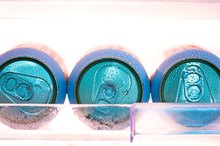What Is MSG Made Of?
Monosodium glutamate, also known as MSG or sodium glutamate, is a sodium salt of the non-essential amino acid glutamic acid. MSG occurs naturally in many foods and scientists originally extracted this sodium salt from seaweed. In manufactured food products, you will typically find MSG labeled as yeast extract, hydrolyzed vegetable protein, HVP, or autolyzed protein. Manufacturers commonly use MSG as a flavor enhancer and as a preservative.
Production of MSG
Manufacturers obtain MSG through a process involving fermentation of carbohydrates with a nitrogen source. For this to happen, manufacturers use certain species of bacteria or yeast such as microbacterium, brevibacterium, corynebacterium, arthrobacter and micrococcus. Originally, manufactures prepared MSG from wheat gluten that has approximately 25 percent glutamic acid. Then, manufacturers started preparing MSG from acrylonitrile and today, fermentation is the method of choice for manufacturing MSG.
Glutamic Acid
What Is Hydrolyzed Soy Protein MSG?
Learn More
According to “Harrison’s Principles of Internal Medicine,” glutamic acid can help nerve cells send and receive information from other cells. Additionally, glutamic acid can decrease or prevent nerve damage caused by anticancer drugs. Further glutamic acid plays a critical role in learning and memory processes. One of the major byproducts of glutamic acid is glutathione, the major antioxidant in your body. Glutamic acid is also the building block of γ-aminobutyric acid, a major neurotransmitter in your nervous system.
Development of MSG
In 1909, Professor Kidunae Ikeda announced in the “Journal of the Chemical Society of Tokyo” that he had isolated a chemical with the molecular formula C5H9NO4. Ikeda stated that this substance resembled the glutamic acid produced by the human body and present in many foodstuffs. Cooking, fermentation or ripening breaks down the protein containing glutamic acid and results in the production of glutamate. Ikeda further identified glutamate as the substance responsible for the taste known as umami or deliciousness. In order to stabilize the chemical, Ikeda used ordinary salt and water, hence the name monosodium glutamate.
Health Concerns
Real Life Uses of Titration
Learn More
The Food and Drug Administration has recognized the general safety of MSG. However, the use of MSG remains controversial because the FDA has received several anecdotal reports of adverse reactions associated with foods containing MSG. These reactions, known as MSG symptom complex, include sweating, headache, numbness, tingling or burning in face, neck and other areas, flushing, heart palpitations, nausea, chest pain and weakness. However, despite these anecdotal reports, the FDA has not issued any warnings regarding the consumption of MSG.
Related Articles
References
- "Food Additives"; Christine Hoza Farlow; 2004
- "In Bad Taste: The Msg Symptom Complex"; George R. Schwartz and Kathleen A. Schwartz; 1999
- "Battling the MSG Myth"; Deborah L. Anglesey; 2007
- "Harrison's Principles of Internal Medicine"; Dennis Kasper et al; 2004
Writer Bio
Jessica Jacobs is a registered dietitian and professional writer, contributing to "Fitness Magazine" since 2003. She received a B.A. in journalism from Arizona State University and an M.S. in nutrition and food sciences from the University of Texas at Austin.







